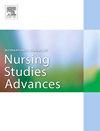Tensions experienced by student and care professionals in a learning and innovation network: a responsive evaluation using storytelling
IF 3.1
Q1 NURSING
International Journal of Nursing Studies Advances
Pub Date : 2025-05-29
DOI:10.1016/j.ijnsa.2025.100360
引用次数: 0
Abstract
Background
Learning and innovation networks are collaborative initiatives between educational and healthcare institutions aimed at integrating the learning of students and care professionals and improving the quality of care through shared practices.
Aim
This study aims to explore how care professionals and students experience learning and working within a learning and innovation network.
Methods
Using a responsive evaluation, we collected data in four iterative phases: (1) interviews with four students and two care professionals to identify themes; (2) development of four fictional stories illustrating tensions based on interview data and practical experience; (3) focus groups with students and care professionals to validate and refine the stories; and (4) a mixed stakeholder group discussion to reflect and start to formulate improvement actions. Thematic analysis was used across all phases.
Results
Participants experienced various tensions, and one of the primary challenges for both students and care professionals was to balance the time allocated between learning activities, care provision and innovation projects. Students faced role ambiguity when performing unsupervised care tasks, feeling part of the team but also vulnerable in their learner status. Care professionals struggled with time constraints and competing demands between patient care and student supervision, which sometimes led to them withdrawing from guiding students. Another tension emerged around engaging in quality improvement. While participants recognized the importance of improving care, engaging in this progress was hindered by a lack of shared understanding of optimal rehabilitation practices and unclear responsibilities regarding implementing innovation. The student-dense environment, though rich in learning potential, heightened these tensions due to differing expectations and unclear roles.
Conclusion
Although learning and innovation networks offer valuable opportunities for mutual learning and improving care, they also introduce tensions that need to be acknowledged and addressed. Managing these tensions, especially around time division, role clarity and a shared vision for improving care, is essential for creating sustainable learning and innovation climates in practice.
学生和护理专业人员在学习和创新网络中经历的紧张关系:使用讲故事的响应性评估
背景:学习和创新网络是教育和医疗机构之间的合作倡议,旨在整合学生和护理专业人员的学习,并通过共享实践提高护理质量。目的本研究旨在探讨护理专业人员和学生如何在学习和创新网络中学习和工作。方法采用响应式评估法,分四个迭代阶段收集数据:(1)与4名学生和2名护理专业人员进行访谈,以确定主题;(2)根据采访数据和实际经验,创作四个描述紧张关系的虚构故事;(3)与学生和护理专业人员进行焦点小组讨论,以验证和完善故事;(4)混合利益相关者小组讨论,以反映并开始制定改进行动。所有阶段都使用了主题分析。结果参与者经历了各种紧张关系,学生和护理人员面临的主要挑战之一是平衡学习活动、护理提供和创新项目之间的时间分配。学生在执行无人监督的护理任务时面临角色模糊,感觉自己是团队的一部分,但在学习者地位上也很脆弱。护理专业人员在时间限制和病人护理和学生监督之间的竞争需求中挣扎,这有时导致他们退出指导学生的工作。另一种紧张关系出现在参与质量改进方面。虽然与会者认识到改善护理的重要性,但由于缺乏对最佳康复实践的共同理解以及实施创新方面的责任不明确,阻碍了这一进展。学生密集的环境虽然有丰富的学习潜力,但由于不同的期望和不明确的角色,加剧了这些紧张关系。尽管学习和创新网络为相互学习和改善护理提供了宝贵的机会,但它们也带来了需要承认和解决的紧张局势。管理这些紧张关系,特别是在时间划分、角色明确和改善护理的共同愿景方面,对于在实践中创造可持续的学习和创新氛围至关重要。
本文章由计算机程序翻译,如有差异,请以英文原文为准。
求助全文
约1分钟内获得全文
求助全文
来源期刊

International Journal of Nursing Studies Advances
Nursing-General Nursing
CiteScore
5.80
自引率
0.00%
发文量
45
审稿时长
81 days
 求助内容:
求助内容: 应助结果提醒方式:
应助结果提醒方式:


